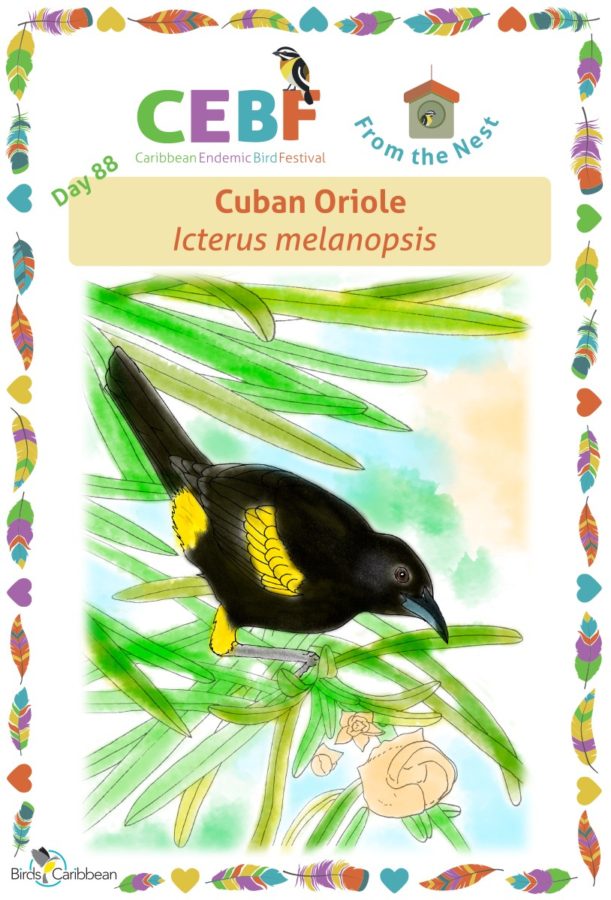Celebrate the Caribbean Endemic Bird Festival (CEBF) with us! Our theme in 2022 is “Loving Birds is Human Nature”. Have fun learning about a new endemic bird every day. We have colouring pages, puzzles, activities, and more. Download for free and enjoy nature with your family at home.
Endemic Bird of the Day: Cuban Oriole
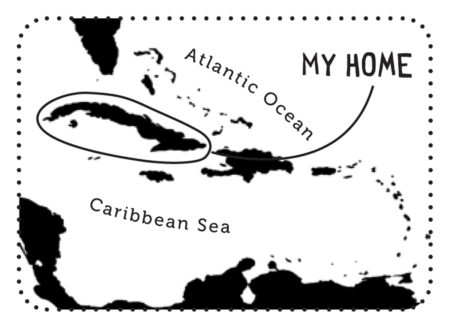 The Cuban Oriole (Icterus melanopsis) can only be found and admired in the Cuban territory, including the main island, the Isle of Youth, and most of the adjacent cays. It was considered a subspecies of the Greater Antillean Oriole, but recently earned its distinction as a unique jewel of Caribbean avifauna. Both males and females are mostly black, with a bright yellow rump, thighs, shoulder patches, and undertail coverts. Juveniles are yellowish-green with a blackish throat.
The Cuban Oriole (Icterus melanopsis) can only be found and admired in the Cuban territory, including the main island, the Isle of Youth, and most of the adjacent cays. It was considered a subspecies of the Greater Antillean Oriole, but recently earned its distinction as a unique jewel of Caribbean avifauna. Both males and females are mostly black, with a bright yellow rump, thighs, shoulder patches, and undertail coverts. Juveniles are yellowish-green with a blackish throat.
The Cuban Oriole is commonly found in pairs and lives in a variety of habitats—from natural and secondary forest, to shrub vegetation, and rural and farm areas. Scientists believe that, like its cousin the Puerto Rican Oriole, both males and females sing complex and diverse musical notes. You can enjoy this melodious song in the form of long and short whistles early in the mornings. Fruits, insects, flowers, and nectar comprise its regular diet—this bird is not picky!
During the breeding season, from February to July, Cuban Orioles show off their engineering skills. Both parents build a most-elaborate nest in the form of a globular basket, with a side entrance, woven with fibers of palm fronds. It is suspended from the underside of branches and big leaves of trees. This provides a secure home for the chicks which will hatch from three greenish white eggs, speckled with lilac gray and olive markings.
Even though it is considered a common resident in Cuba, in some places, it is becoming hard to find and populations may be declining. More study is needed, but scientists believe the cause of this apparent decline is nest parasitism by the Shiny Cowbird (Molothrus bonariensis). Additionally, its beautiful song makes it susceptible to being trapped and kept as a pet, an ongoing challenge for bird conservation in Cuba. We can all help to conserve this charismatic endemic, and many others, through education and advocacy for the protection of birds and their habitats. Learn more about this species, including its range, photos, and calls here.
Colour in the Cuban Oriole
Download our West Indies Endemic Bird colouring page. Use the photos below as your guide, or you can look up pictures of the bird online or in a bird field guide if you have one. Share your coloured-in page with us by posting it online and tagging us @BirdsCaribbean #CEBFfromthenest
Listen to the song of the Cuban Oriole
The song of the Cuban Oriole is series of clear upslurred and down-slurred whistled notes.
Puzzle of the Day
Click on the image below to do the puzzle. You can make the puzzle as easy or as hard as you like – for example, 6, 8, or 12 pieces for young children, all the way up to 1,024 pieces for those that are up for a challenge!
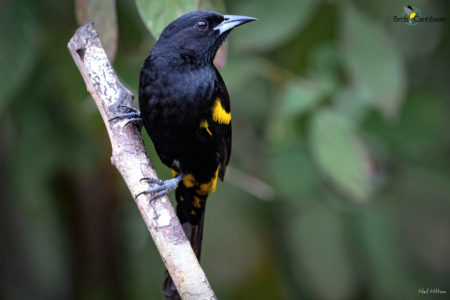
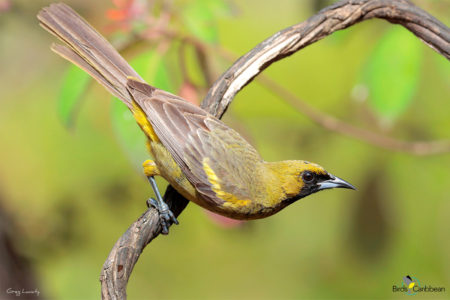
Activity of the Day
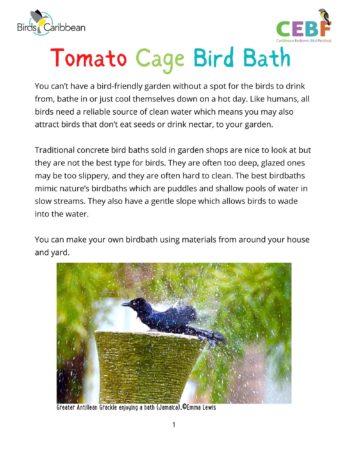 FOR KIDS AND ADULTS: You can’t have a bird-friendly garden without a spot for the birds to drink from, bathe in or just cool themselves down on a hot day. Like humans, all birds need a reliable source of clean water. Follow our instructions and you can make your own bird bath using materials from around your house and yard. You will need, an old garbage bin lid, flower pot drip tray or serving tray;
FOR KIDS AND ADULTS: You can’t have a bird-friendly garden without a spot for the birds to drink from, bathe in or just cool themselves down on a hot day. Like humans, all birds need a reliable source of clean water. Follow our instructions and you can make your own bird bath using materials from around your house and yard. You will need, an old garbage bin lid, flower pot drip tray or serving tray;
rocks or pebbles; any size and color tomato cage and wire cutters. As this activity involves using wire cutters you will need to ask an adult to help you.
Once you have made your bird bath make sure that you follow our “Keeping your bird bath safe for the birds & you” tips. By frequently changing the water and keeping your bird bath clean you should be able to provide a place for the bird in your garden to enjoy and for you to enjoy the birds!
Enjoy the video below of Cuban Oriole enjoying a tasty meal of some flowers!
Find out how BirdsCaribbean has been increasing bird tourism capacity in Cuba through the Caribbean Birding Trail Guide training program. Cuba has 26 endemic birds, engaging with visitors to the Island to help them to understand the secret lives of these birds is a special skill. In October 2017 the Caribbean Birding Trail Interpretive Guide Training course taught 26 persons how to connect visitors with the cultural and natural resources of the island. Read more about it in this account from course participant, Mariana Pedraza.

